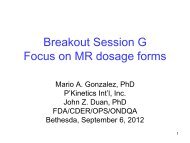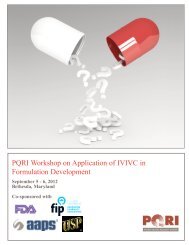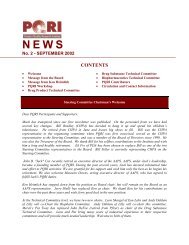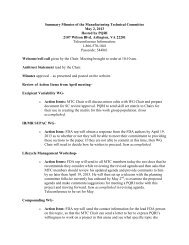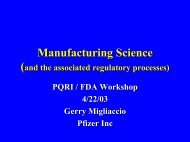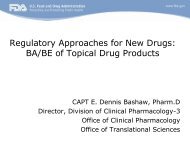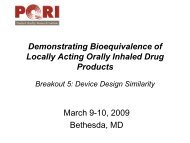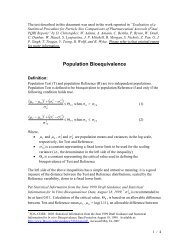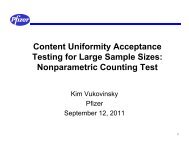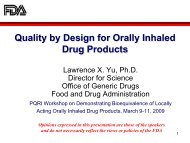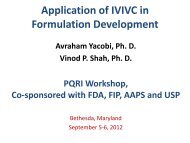Determination of Water Vapor Transmission Rate for High ... - PQRI
Determination of Water Vapor Transmission Rate for High ... - PQRI
Determination of Water Vapor Transmission Rate for High ... - PQRI
You also want an ePaper? Increase the reach of your titles
YUMPU automatically turns print PDFs into web optimized ePapers that Google loves.
provided a theoretical basis <strong>for</strong> using WVTR per unit dose as a means to compare<br />
different container-closure systems.<br />
Materials and Methods<br />
The bottles used were 60mL HDPE with 28mm double lead semi interrupted threads.<br />
The HDPE resin was Phillips Marlex 5502 BN. The bottles were manufactured by<br />
Rexam. The closures used were 28mm diameter polypropylene (PP) with Squeeze and<br />
Turn child-resistant feature. The PP resin was Phillips-Sumika HLN 120-01. The closures<br />
were manufactured by Rexam. The cap liners were supplied by Selig with FS 1-7 innerseal<br />
and C25P liner. The materials <strong>of</strong> construction <strong>for</strong> the inner-seal and liner were<br />
0.0015” medium density polyethylene (MDPE)/0.001” Al foil/Heat Tac Wax/0.005”<br />
Paper/0.030” Polyolefin Foam.<br />
The bottles were uniquely identified, then filled with an appropriate amount <strong>of</strong> anhydrous<br />
calcium chloride desiccant and induction-sealed in accordance with USP . See<br />
Appendix A <strong>for</strong> details about selection <strong>of</strong> desiccant. The containers were all filled and<br />
sealed at the same time at one site (Pfizer). For details <strong>of</strong> sample preparation, see the<br />
protocol in Appendix B. The seals <strong>of</strong> a designated number <strong>of</strong> these bottles were then<br />
broached and the bottles re-capped according to the procedure prescribed in USP .<br />
On receipt at the testing laboratory, the seals <strong>of</strong> a designated number <strong>of</strong> these bottles were<br />
then broached and the bottles re-capped according to the procedure prescribed in USP<br />
. The broached seals were prepared as follows: The cap <strong>of</strong> the induction sealed<br />
bottle was removed, and the seal was cut around the inner circumference <strong>of</strong> the mouth<br />
with a sharp razor blade. The cut-out material was removed, taking care to leave a flat,<br />
unbroken area <strong>of</strong> inner-seal on the land <strong>of</strong> the bottle finish. The caps were then reapplied<br />
to the bottles in accordance with the procedure in USP . The details <strong>of</strong> the<br />
broaching procedure are given in Appendix C.<br />
Subsequently, both the intact and broached bottles were stored in environmental<br />
chambers controlled at 40±2°C/75±5%RH or 23±2°C/75±3%RH at the four sites:<br />
Abbott (AB), Merck Sharp & Dhome (MK), Pfizer (PF) and san<strong>of</strong>i-aventis (SA).<br />
A testing protocol was developed that required each laboratory to per<strong>for</strong>m WVTR tests as<br />
follows:<br />
1) 15 Broached bottles with desiccant, 10 control samples without desiccant stored at<br />
40±2°C/75±5%RH and weighed at 7 day intervals <strong>for</strong> 49 days.<br />
2) 15 Broached bottles with desiccant, 10 control samples without desiccant stored at<br />
23±2°C/75±3%RH and weighed at 7 day intervals <strong>for</strong> 49 days.<br />
Product in the Evaluation <strong>of</strong> Moisture-Barrier Equivalence <strong>of</strong> Primary Packages <strong>for</strong> Solid Oral Dosage<br />
Forms”, Pharmacopeial Forum (2005) 31(1) Jan-Feb, 226-269<br />
2



